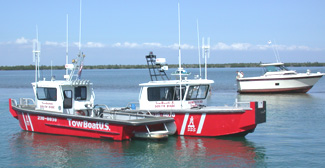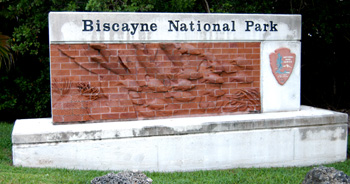
Park preservation: How much is enough?
HOMESTEAD, Fla.— Remember the phrase, “things aren’t always as they seem?”
Check out Biscayne National Park.
Set on a grassy area dotted with exotic plants and trees, this small, green landscape overlooks the majority of the park, which is 95 percent covered by clear, aquamarine water.
Cheerful picnickers overlook the tiny islands dotting the horizon in the distance, while snorkelers and boaters enjoy the clear blue ocean. Seems like paradise, right?
Wrong. Visitors, specifically boaters, which come to enjoy Biscayne National Park, are the main contributors to both environmental problems and pollution in the water.
 |
Pleasure boats that run aground in the shallows in Biscayne National Park can damage the fragile bay bottom and rare living coral reefs (Staff photos). |
Where does one point the finger in a situation like this? “Most of our visitation is coming from within the United States—wherever it’s cold,” said Gary Bremen, park ranger.
And apparently, Americans visit the park over and over. “This is my fourth trip here,” said Kathy Klein from Colorado. “We just rode the motorcycle in from the campground.
Klein is not the only out-of-towner enjoying the weather. “We love it here. This is better than Indiana weather right now,” said Lee Tipton. “We’re just hanging out for a little while.”
And that’s what the park is there for: enjoyment—but to a limit. In 1968, President Lyndon Johnson declared a large part of the area as a national monument. In 1980, an act of Congress enlarged the area to 180,000 acres and established Biscayne National Park.
Coral reefs line the bottom of the ocean, and provide food and shelter to thousands of fish, plants, coral, and other animals, and although they seem strong, reefs are actually quite fragile and vulnerable to destruction by over-fishing, physical damage and pollution. Are tourists seeking warm weather and water destroying these natural resources?
“The biggest environmental problem inside the park is probably boat riders. We have very fragile sea grass beds. Boaters who don’t know what they’re doing, which is a large number of them because there are no licensing requirements in the state of Florida, plow along without realizing it, right into a bed of sea grass,” said Bremen.
Apparently, it’s not the tourists who are the problem.
“Although we have a lot of tourists, on weekends, the park, especially out in the water, is really a locals place because most people coming from Minneapolis are not bringing their boats,” said Bremen.
And what kind of situations can we expect from locals?
 |
Turkey Point nuclear power plant, located south of the Visitors Center, is always a potential danger for the fragile environmental area within Biscayne National Park. |
“There was one case just below Key Biscayne where a guy went outside a clearly marked channel. He blew out a hole that was about 10 feet deep and about the size of one and a half tennis courts.
His fines included $25,000 in criminal fines for reckless boating and drunk boating—he was drunk. And then $106,000 in restitution to restore the area. Plus all the damage to his boat, plus the house arrest, plus being banned from the park. He did end up paying, the money probably didn’t mean a whole lot to him. Unfortunately, people with that kind of money, they put up with a lot of that. They don’t care,” said Bremen.
What can we do to help save this fragile, underwater ecosystem?
Even without human impact, coral reefs battle for survival. Coral polyps are eaten by fire worms, grazed by snails, bored by sponges, crushed by parrot fish, colonized by algae and coated with sand and sediments. The actions of humans can protect or destroy this unique and fragile environment.
The National Park Resources Protection Act allows national parks to recover for damages to national park resources. This act ensures restitution, although it does not seem to be protecting Biscayne as well as it should.
“Biscayne National Park probably uses that law or has used that law more than any other national park in the system,” said Bremen. “It was created largely in response to the Exxon Valdez oil spill in Alaska. There was so much damage from that, but there really wasn’t a law that allowed people to recover money.”
And it is about time that this badly needed law took effect. The England Moon, a German freighter on its way from Saudi Arabia to Houston, was carrying chemicals when it plowed right into the Biscayne coral reef in 1997. There was also the situation when the Ally B, which was a tugboat pulling a tanker full of sugar, destroyed two miles of reef in Biscayne.
 |
| A school of fish is hidden in the surface of the red brick. |
Is it possible to fix damage like that?
“The Ally B hasn’t been settled yet, but the England Moon was settled for $1 million. It probably cost more than that but the litigation would have cost money too, and it just wasn’t worth it—we wanted to get it going,” said Bremen.
“Repairing a sea grass bed is not like patching a wall. You’ve got the constant action of waves and currents. Sea grasses are very picky. They’re very particular about their sediment sizes. Turtle grass sends out rhizomes. They won’t grow down a slope, so if you blow out a hole, you have to fill it. It’s not like you go to Home Depot to pick up your sea grass either. You have to get it from some place, which damages another spot. So there’s a lot of issues.”
Obviously, damage to the sea grasses and coral beds is a huge problem, but it is not the only issue with which Biscayne National Park has to deal. Because the park is mostly underwater, there is no way to control trash that washes in from the shipping lines.
Is Biscayne National Park, a segment of land and water that encompasses the natural beauty of old Florida doomed to distinction? It seems a waste that such a carefully preserved area may be lost because boaters are not willing to just slow down.
What does Bremen, the park ranger, have to say? “When you get an ecosystem which is already stressed out by so many factors, it’s very hard for it to recover.”
Let’s hope Biscayne National Park does.

Comments are Closed